Executive Summary
The British economy expanded only modestly in Q4, with real GDP rising 1.5 percent year over year. While overall production increased in the quarter with growth across multiple sectors, real personal consumption expenditures (PCE) and investment spending have remained depressed over the past year in the wake of the Brexit Referendum in 2016. In this report, we examine the uncertainties surrounding Brexit negotiations and our outlook for 2018.
The sharp depreciation of sterling after Brexit led to a rise in inflation that subsequently eroded income growth and led to a drag on consumer spending. Growth in investment spending also slowed over the past year as Brexit uncertainties likely cautioned more expansionary business decisions. While there are still unknowns surrounding Brexit negotiations, the British economy looks poised to regain its momentum over the coming year. A pullback in inflation and strengthening real PCE growth, along with strengthening investment intentions, should be supportive of overall GDP growth. While the Bank of England (BoE) will likely remain on hold in the coming months in the midst of only slowly improving growth and softer inflation, our currency strategy team looks for the value of sterling to increase modestly against the dollar over the coming year amid general greenback weakness. We look for the U.K. economy to slowly return to growth rates closer to 2 percent over the coming quarters.
U.K. Economy Expands Modestly in Q4
Preliminary data that were released today showed that real GDP in the United Kingdom rose 0.5 percent (2.0 percent on an annualized basis) in Q4-2017 relative to the previous quarter (Figure 1).
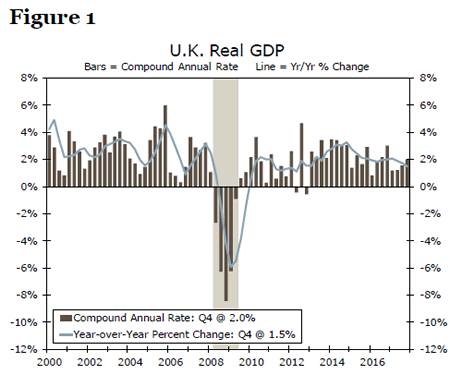
While the quarterly growth rate came in slightly above consensus, on a year-ago basis real GDP grew 1.5 percent, which was below the 1.7 percent Q3 print. The British economy expanded 1.8 percent in 2017, slightly below the 1.9 percent rate registered in 2016. A breakdown of the GDP data into its underlying demand components is not available at this time. However, industry-level data included in today’s release showed modest expansion in the service sector, up 0.6 percent for the quarter. On the production side, total production was up a solid 0.6 percent for the quarter, led by the manufacturing sector, up 1.3 percent. The construction and mining sectors were a drag on growth in the quarter, down 1.0 percent and 3.9 percent respectively.
While we do not have demand side data at this time, personal consumption as measured by real retail sales has remained lackluster over the past year. Average monthly growth in real retail sales slowed in 2017 to around 2 percent year over year, compared to almost 5 percent in 2016. As we discuss in more detail below, the aftermath of Brexit saw a slowdown in overall consumer spending as rising inflation eroded purchasing power. However, inflation is starting to recede, which should lift purchasing power and thereby support growth in personal consumption expenditures in the coming quarters. A disaggregation of the Q4 GDP data into its underlying demand components will be available on February 22.
The Shock from Brexit is Starting to Fade
As Figure 1 makes clear, real GDP growth in the United Kingdom has downshifted over the past few quarters. Figure 2, which plots the contributions to the overall rate of GDP growth from individual demand components, shows that much of the deceleration in the British economy over the past few quarters stems from slower growth in real personal consumption expenditures (PCE). At the same time, net exports (NX) have helped to shore up the overall rate of GDP growth. These changing fortunes in two demand components of GDP reflect the same catalyst, namely, the sharp depreciation of the British pound in the immediate aftermath of the Brexit referendum in 2016.
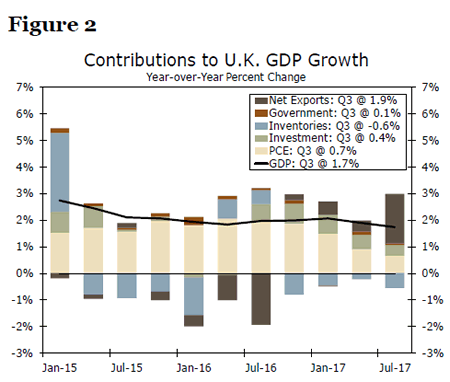
As shown in Figure 3, the trade-weighted value of sterling was down nearly 20 percent on a yearago basis in October 2016. This sharp depreciation in the value of the British pound has helped to lift U.K. export growth in recent quarters. But by raising import prices, sterling depreciation also contributed to the marked increase in the CPI inflation rate. Because there has been little acceleration in wages, higher inflation eroded growth in real disposable income (i.e., purchasing power). As shown in Figure 4, growth in real disposable income, which has a fair degree of correlation with growth in real consumer spending, weakened over the course of 2017.
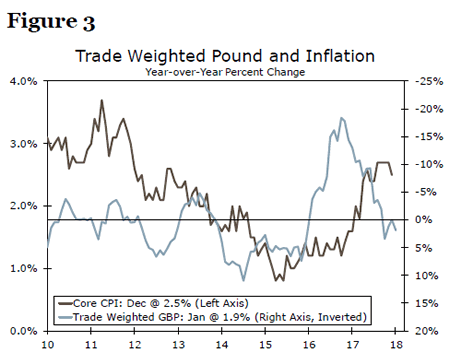
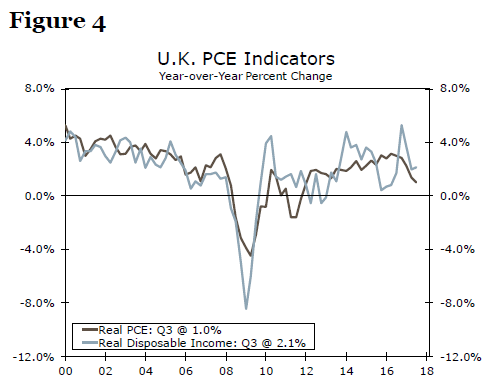
But the dynamics that led to a deceleration in consumer spending are starting to reverse. The trade-weighted value of sterling is now more or less flat on a year-ago basis. Consequently, the inflationary impulses that hit the economy via rising import prices are starting to weaken. Therefore, CPI inflation should recede in coming months, which should lead to stronger growth in real disposable income and some re-acceleration in consumer spending.
Growth in investment spending also slowed in 2017. As shown in Figure 5, gross fixed capital formation (GFCF) grew nearly 6 percent on a year-ago basis in Q1-2017, but growth had slowed to about 2 percent by Q3-2017. Drilling down into the components of GFCF shows that the slowdown was broad-based. Not only did growth in investment spending by the business sector downshift, but public sector investment declined on a year-ago basis in Q3-2017. "Other" investment (largely residential investment) also decelerated over the course of 2017. But there is some room for optimism going forward. A survey of investment "intentions," which has a fair degree of correlation with growth in actual investment spending, edged higher in the fourth quarter (Figure 6).
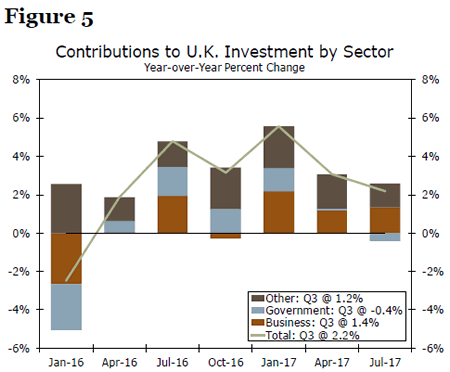
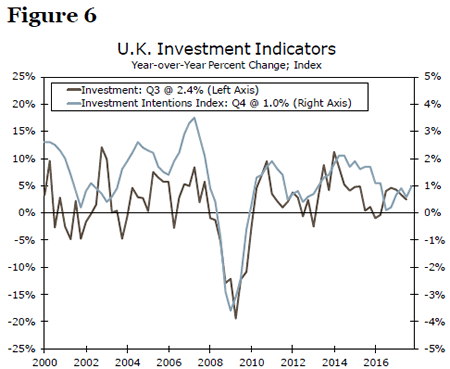
But Brexit Remains the Elephant in the Room
Our forecast looks for the year-over-year rate of real GDP growth in the United Kingdom to pick up from 1.5 percent in Q4-2017 back toward 2 percent by the end of 2019 (Figure 7). This forecast is predicated on the assumption that uncertainties related to Brexit do not weigh unduly on investment spending decisions. Prime Minister May’s decision last year to trigger Article 50 of the Treaty on European Union means that the United Kingdom will formally leave the European Union on March 29, 2019. Some of the uncertainty related to Brexit was cleared up in December when U.K. and EU negotiators agreed to the terms of their "divorce."1 It is also likely that the arrangements that currently govern economic and financial transactions between the United Kingdom and the rest of the European Union will remain in place for about two years after March 2019. So negotiators will likely have between now and March 2021 to come up with a new framework for their economic and financial transactions.
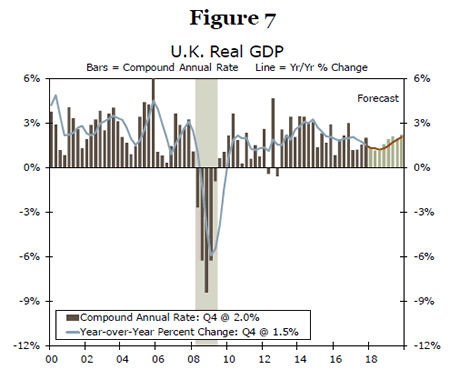
But there still is significant uncertainty regarding those arrangements. Will trade in goods and services between the United Kingdom and the rest of the European Union remain tariff-free or will tariffs or other trade restrictions be placed on those goods and services? Will the United Kingdom maintain its "passport," which allows British financial institutions to freely offer financial products and services in the rest of the European Union? Nobody knows the answer to these and myriad other questions at this time. We are hopeful that this uncertainty will not cause businesses to shelve investment spending plans in the United Kingdom until the uncertainty is cleared up, but we acknowledge the risk that they could. Although it is not our base-case view, the risk of an investment-led recession in the United Kingdom in coming quarters is not insignificant.
Bank of England Likely Will Remain on Hold in Coming Months
The Bank of England is also mindful of the downside risks posed to the British economy from Brexit uncertainty. In its most recent policy statement the Monetary Policy Committee (MPC) explicitly stated that "developments regarding the United Kingdom’s withdrawal from the European Union—and in particular the reaction of households, businesses and asset prices to them—remain the most significant influence on, and source of uncertainty about, the economic outlook."
The uncertainty that spiked in the immediate aftermath of the Brexit referendum led the MPC to cut its main policy rate by 25 bps in August 2016 (Figure 8). Although the economy decelerated, it did not slip into recession as some had feared immediately after the referendum. Consequently, the MPC judged in October 2017 that its "insurance" rate cut was no longer needed, and it returned its Bank Rate to 0.50 percent where it remains today. In our view, growth will remain slow enough over the next few quarters to keep the MPC on hold. By the end of the year, however, real GDP growth should be showing signs of strengthening anew. We forecast that the MPC will tighten by 25 bps in Q4-2018, and we look for two more 25 bps rate hikes over the course of 2019.
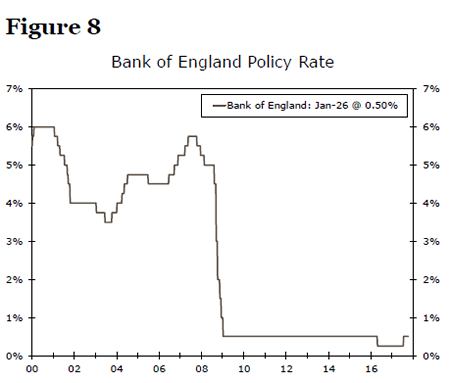
As shown in Figure 9, the British pound rose about 10 percent on balance in 2017 vis-à-vis the U.S. dollar following its marked decline from 2014 through 2016. Looking forward, Wells Fargo’s currency strategy team expects that sterling will continue to trend slowly higher against the greenback in the context of broad-based dollar weakness. That said, our strategists look for the British pound to weaken modestly versus the euro in coming quarters.
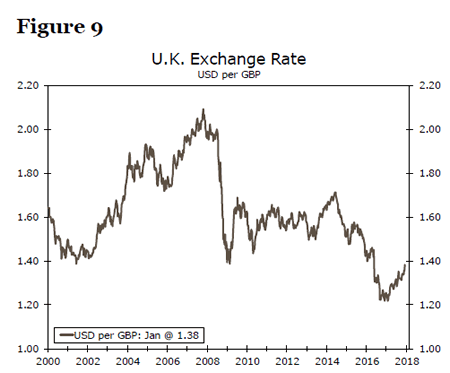
Conclusion
Real GDP in the United Kingdom rose 1.5 percent in Q4 year over year, led by a solid increase in overall production, yet likely only modest growth in consumer spending. In the wake of the Brexit referendum in 2016, sterling depreciation and subsequent increases in inflation led to a pullback in real PCE and investment spending over the past year. However, the slowdown is likely starting to reverse as inflation begins to recede, wage growth slowly begins to pick up and investment intentions strengthen. A relatively stable trade-weighted value of sterling should also support a softening in inflation. In the midst of an improving outlook, Brexit negotiations still present uncertainties for the British economy, as the U.K. and European Union must determine the future of economic and financial relationships currently in place. The BoE will also likely maintain a cautious approach to tightening policy as Brexit negotiations continue, inflation slows and growth gradually picks up. Our currency strategy team looks for the value of sterling to gradually appreciate against the dollar in the coming quarters in the midst of general greenback weakness. We look for the British economy to return to growth rates closer to 2 percent by the end of 2019, assuming Brexit negotiations do not reverse the gradual improvement in consumer and investment spending in the meantime.














